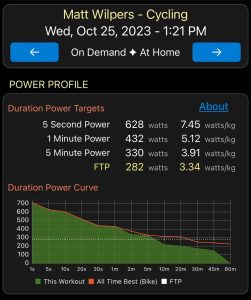New Metric Added to Power Zone Training!
New Metric Added to Power Zone Training!
Those of you who regularly do Power Zone rides probably know that Matt Wilpers usually teaches a live Power Zone class just about every Saturday morning. Those riding Matt’s October 7th Power Zone Max ride were in for something special. For the first time, Matt incorporated a Power Profile test into a Power Zone ride. For more in-depth information on this test, check out this article.

What, another test?
Power Zone riders are certainly familiar with the dreaded FTP (functional threshold power) test that measures the maximum power a rider can sustain over a 20 minute ride. From that test are derived 7 individualized Power Zones that form the basis of Power Zone training.
If you’re new to the Power Zone concept in general, you should check out Peloton’s Discover Your Power Zones program where the instructors provide a much more detailed explanation of what Power Zone training is and what it can do for your training.
As Matt mentions during the October 7 ride, the FTP test is generally an endurance test designed to measure a rider’s overall average power output over 20 minutes. The Power Profile test digs a little deeper into your power numbers and provides a more personalized profile for each rider.
How Does the Power Profile Test Differ from FTP?
The Power Profile test is designed to identify specific strengths and weaknesses in our own riding ability. For instance, the test may reveal that you excel at longer endurance rides, while perhaps struggling a bit with sprints that require much more power, but at shorter durations. The results allow you to identify your specific riding profile and identify which types of rides might help you reach your specific training goals. More on that in a bit.
What Does the Test Involve?
Matt begins the ride as he does in a typical Power Zone class. He starts with a 15 minute warm-up, and then a build-up as follows:
2 minutes Zone 2
2 minutes Zone 3
1 minute Zone 4
30 seconds Zone 5
30 seconds Zone 6
After a one-minute recovery, the actual test begins and the real fun starts. Be sure to listen to Matt’s instructions, as the goal is to maintain your maximum output over the following intervals regardless of what Zone you happen to be in.
1 minute maximum effort (for many riders, this will be your Zone 6)
5:30 recovery (Zone 1)
5 minute maximum effort (for many riders this will be somewhere in Zone 5)
5:30 recovery (Zone 1)
The test concludes by repeating the following intervals 6 times –
15 seconds maximum effort (for many riders this will be somewhere in Zone 7).
2 minute Zone 1 recovery.
Ok, I’ve Done the Test, Now What?
When you finish the test, your Peloton bike will display your normal Power Zone graph and from that you can determine how well you were able to maintain your efforts over the various intervals.
At this time, we do not know whether Peloton will incorporate specific Power Profile graphs into your completed ride profile, or to what extent they will rely on the Power Profile metric information in future Power Zone rides and or programs. The third-party mPaceLine app does import your Peloton rides and produces a Power Profile Graph. Keep in mind that these features are only available to paid subscribers to their service. Here is my graph from Matt’s test ride.

My digging a little more into the Power Profile concept and looking at my results, I know that I’m better at endurance riding rather than quick, powerful sprint efforts.
Power Zone Pack has also announced that they will be incorporating Power Profile information into their website for and soon to be released app. These features are available only to paid subscribers to their service.
Using Your Power Profile to Improve Training
Once your Power Profile is determined, you should be able to identify what types of riding that would help best achieve your training goals. For instance, if you are looking to improve endurance for longer sustained climbs, you would likely focus on longer efforts in Zones 2-4, while those looking to improve power for sprinting might want to focus on riding a bit more in Zones 5-7.
Tell us What You Think?
Have you taken Matt’s Power Profile test ride? If so, we’d love to know what you think of it and if you plan to use your Power Profile in your training.
P.S. Don’t Forget Matt’s Two-Hour Power Zone Ride on Saturday
In further celebration of Matt’s 40th birthday, he is teaching the first ever two-hour Power Zone class this Saturday at 7:00 (Eastern). So far, over 6000 riders are signed up for it. We hope to see you on the leaderboard. And don’t forget to bring a banana, or two!
Tune in to The Clip Out every Friday to hear Tom and Crystal’s take on this and other hot Pelotopics. We’re available on Apple Podcasts, Spotify, Google Podcasts, iHeart, TuneIn. Be sure and follow us so you never miss an episode. You can also find the show online on Facebook.com/TheClipOut. While you’re there, like the page and join the group. Lastly, find us on our YouTube channel, YouTube.com/TheClipOut, where you can watch all of our shows.
See something in the Peloton Universe that you think we should know? Visit theclipout.com and click on Submit a Tip!

Subscribe
Keep up with all the Peloton news!








